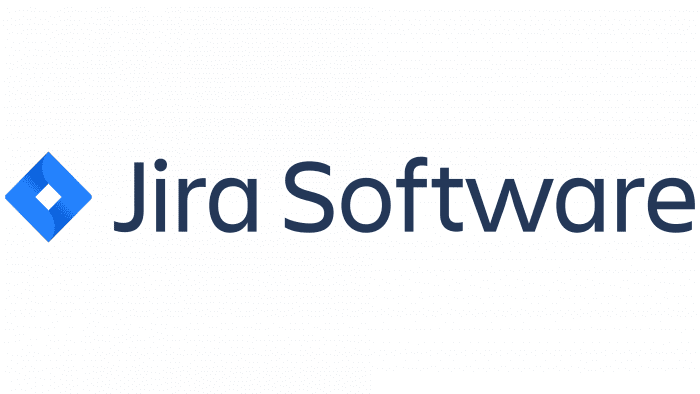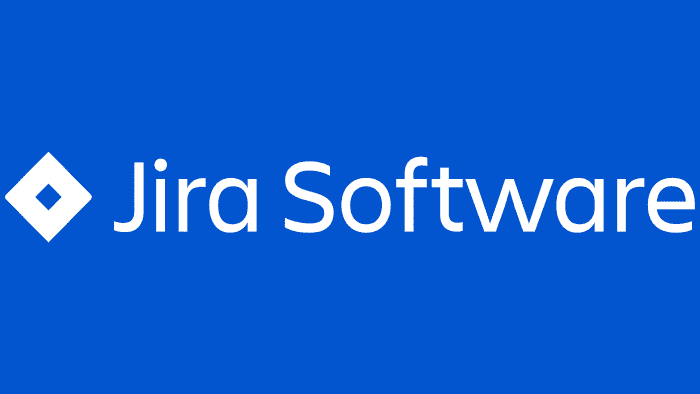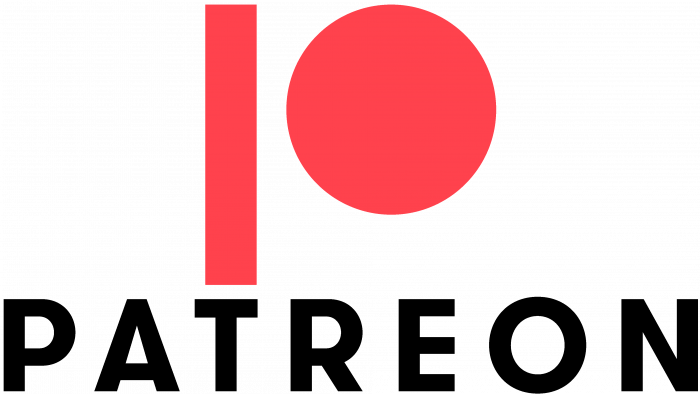The Jira logo is an example of a focus on results. The visual sign attracts attention with its shape and play of color. Shows a clear focus on the problem and the ability to fix it gracefully—smooth and consistent work to get the ideal.
Jira: Brand overview
| Founded: | 2002 |
| Founder: | Atlassian |
| Website: | atlassian.com |
Meaning and History
The structure of the logo includes a graphic designation and a word symbol of the brand. The name Jira was derived from the Japanese word “Gojira.” And it, in turn, is translated as “Godzilla.” This is the nickname Atlassian employees once gave to the Bugzilla web system they used.
The bug tracker received its current logo in the form of a blue diamond shape relatively recently, after a global redesign of the parent company. The developers have changed the visual identity of all products to make them unified. After all, in addition to Jira Software, there are Opsgenie, Jira Service Management, and Jira Core packages. Together they form the Jira family. There are also other brands – a total of 14.
What is Jira?
This software is designed for project management and direct interaction within their framework. It is designed for groups of users of any size and is used to eliminate errors. The author of the software is the Australian company Atlassian.
The old identity system was based on a mythological character named Atlas, who held the sky. Therefore, Atlassian and the Jira family had a similar logo: two intersecting lines with a small triangle on top. The set of geometric shapes looked like an abstract human with raised hands. The rest of the products also had their symbols, but they stood out from the general concept.
Due to the stylistic inconsistency between the logos and inappropriate connotations, the company owners decided to make the identity coherent. Strategist Leah Pincsak led the process. Typographer James Edmondson was responsible for the wordmark, graphic artist Trace Byrd was responsible for illustration, and branding specialist Angy Che was involved in the design.
The creative team redesigned the Atlassian product logos to remove the legacy Atlas image. This gave the Jira family a completely new look, including individual symbols for all software packages. Now each product has its unique blue badge. Jira Software has a rhombus, Jira Service Management has two semicircles connected by raised sides, Opsgenie has a checkmark with a small circle at the top, and Jira Core has a paper airplane shape.
The Jira Bug Tracker logo cannot be viewed in isolation from other Atlassian graphics because they are related. The development team tried to put a deep meaning in the – common for everyone and at the same time individual for each product. Together, the family logos represent a single brand.
Jira Software’s geometric symbol is based on two triangular brackets. They added thickenings to them and then connected them to make a diamond. It is now a simple emblem with two repeating segments that create a sense of movement. There is momentum, clear vision, and direction in the image. At first glance, an abstract figure does not express the essence of the program in any way. But she does this – hidden, unobvious, and at the level of allegories.
Jira: Interesting Facts
Jira, made by Atlassian, is a key tool for project management and tracking issues. It is widely used by companies, especially for agile development. It started in 2002 and has grown from a basic issue tracker into a robust platform for managing projects, software development, bug tracking, and more.
- Name Origins: “Jira” comes from “Gojira,” the Japanese name for Godzilla, chosen to rival Bugzilla, another bug-tracking tool.
- Used in Many Fields: Originally for software developers, Jira now helps various industries manage projects, tasks, and workflows, not just in IT but also in finance, marketing, HR, and operations.
- Highly Customizable: Jira is known for its customization. Users can adjust workflows, fields, and more to fit their project needs, making it compatible with different project management styles like Scrum and Kanban.
- Extensible with Add-ons: The Atlassian Marketplace lets users enhance Jira with plugins for more features, like tool integrations, custom reports, and workflow improvements.
- Different Versions for Different Needs: Jira comes in versions like Jira Software for development teams, Jira Work Management for business teams, and Jira Service Management for IT and service desks.
- Widely Used: Thousands of companies globally, including 80% of the Fortune 500, use Jira, showing its effectiveness in various settings.
- Supports Agile Management: Jira Software is praised for its agile project management tools, offering features essential for Scrum, Kanban, and other agile methods.
- Works with Other Atlassian Tools: Jira integrates well with other Atlassian products, such as Confluence, Bitbucket, and Trello, creating a full project management and collaboration ecosystem.
- Cloud and On-Premise Options: Jira offers both cloud-based services and self-managed options, meeting the preferences of different businesses.
- Keeps Getting Better: Atlassian frequently updates Jira with new features and improvements, keeping it up-to-date with user needs and industry trends.
Jira has evolved into a crucial tool for project management and issue tracking, adaptable across many industries. Its broad range of features and extensions makes it essential for teams looking to improve their workflows and productivity.
Font and Colors
James Edmondson, who was in charge of typography, played one of the team’s most important roles. He had to make all brands consistent because the old Klavika typeface looked bad when downsized and had long since ceased to be associated with Atlassian products.
The specialist has developed a custom font Charlie Sans – a whimsical and upbeat sans serif with smooth lines and curves to solve this problem. It is he who is now used for the inscription “Jira Software.” The logo doesn’t show this, but the typeface contains an uppercase “A” with a thin border, which is a nod to the old Atlas emblem. By the way, she was also unofficially called Charlie.
The graphic element is colored in a soothing blue, and the name of the software package is in neutral gray. If the background is dark, brand owners allow a white version.
FAQ
What do the symbols mean in Jira?
In Jira, symbols provide visual cues about the status of releases and issues:
- A blue icon means your release is on track, indicating progress is as expected without major issues.
- A green icon shows a shipped release, signifying it has been completed and delivered.
- A red icon indicates issues assigned to it extend beyond your release date, suggesting delays or missed deadlines.
These symbols help users quickly understand project status and identify potential problems, allowing teams to maintain oversight and ensure timely delivery.
What does Jira stand for?
Jira is not an abbreviation. The name “Jira” comes from the word “Gojira,” which means Godzilla in Japanese. Atlassian’s earlier software tool, Bugzilla, inspired this name.
The creators wanted a name that was easy to remember and connected to Bugzilla, which was used for tracking bugs in software development. By choosing “Jira,” they kept a playful link to managing and tracking issues, much like Godzilla is a powerful presence. This name reflects the brand’s goal of creating a strong and effective tool for project management and issue tracking.
Who created Jira?
The brand was created by the Australian company Atlassian, founded by Michael Cannon-Brookes and Scott Farquhar. Using their funds, they developed Jira.
Michael Cannon-Brookes and Scott Farquhar started Atlassian in 2002. They wanted to build software tools to help teams collaborate and manage projects better. Jira was one of their first products, helping software development teams track bugs and manage tasks. Over time, it has become a comprehensive project management and issue-tracking tool used worldwide. The success of other Atlassian products has made the company a major player in the software industry.
Can I use the Jira logo?
You can use the logo to identify Atlassian products and promote the brand. You don’t need written consent from the owners as long as you use the logo exactly as it is, without making any changes.
Here are some guidelines to follow:
- Purpose: Use the logo only to refer to Atlassian products or promote the brand.
- Integrity: Do not alter the logo. This includes not changing the colors, resizing it incorrectly, adding effects, or modifying its design.
- Placement: Place the logo clearly and visibly. Avoid placing it on busy backgrounds or alongside elements that might obscure it.
- Proportion: Keep the original proportions when resizing. Do not stretch or squish the logo.
- Context: Use the logo in a positive and appropriate context. Avoid using it in misleading or inappropriate ways.
What is a Jira application?
The Jira application is a versatile tool for project management, problem identification, history tracking, and bug tracking. It helps teams across various industries manage and streamline their workflows.
Users can create and assign tasks, set deadlines, and track progress in real-time. The app’s intuitive interface makes it easy for team members to collaborate, communicate, and stay updated on project status.
A key feature is its bug-tracking capability. Users can report, monitor, and resolve issues quickly, which is especially useful for software development teams.





